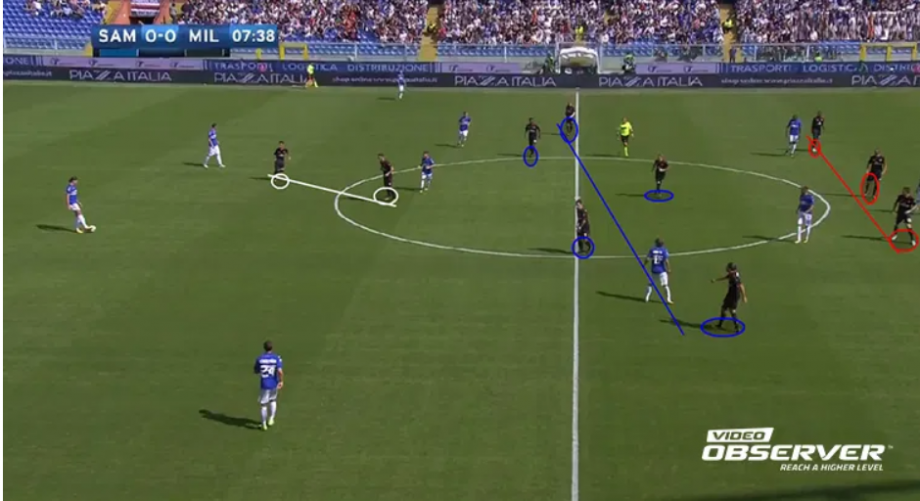AC Milan has changed to a 3-5-2 ever since the 4-1 defeat against Lazio. The Italian team has now 4 wins and 1 loss, having scored 12 goals and conceded 6. We now present our analysis on the AC Milan’s defensive organization, after watching the match against Sampdoria.
The Italians maintain their full-backs high up the pitch; they’re positioned on the same line as the defensive midfielder in a 1-3-5-2, preventing the opponent’s from using their wingers. When necessary, the team adjusts the full-backs positioning and the 1-3-5-2 transforms into a 1-5-3-2.
All players defend in their own half; the goalkeeper Donnarumma and the three defenders Zapata, Bonucci, and Romagnoli remain deep on the pitch, controlling the depth and the central defensive space.
The full-backs Abate and Rodriguez are positioned on the same line as midfielders, and their aim is to condition the opponent’s offensive process.

Three well-defined defensive lines with the full-backs positioned on the same line as the midfielders, creating a 5-player block that presses as a whole.
The midfielders Biglia, Kessie, and Bonaventura aim to prevent the opponent from creating chances in the central space, as well as 1) ensure coverage to the wing-backs (especially Kessi and Bonaventura) when the opponent explores the spaces behind them, and 2) chase the opponent midfielders when they move to the side spaces. Suso and Kalinic form the first pressing line.

With the team playing deeper, the full-backs remain on the same line as the midfielders. This means the defensive covers are far from the full-backs, which weakens the defensive structure.

Milan’s inside players play a key role in the defensive organization, either conditioning the opponent from creating chances or covering the full-backs when they press the opponent high up the pitch.


The pressing zone is well-defined. AC Milan moves and presses collectively and so it is able to recover many balls on the defensive/intermediate side lanes, as well as on the space ahead of the box (the three center-backs play a key role here).
When we look at the data registered through Videobserver regarding the ball recoveries, we can easily detect the pressing zones (side spaces – there were more ball recoveries on the right side) as well as the areas where Milan players are positioned on the defensive organization. Nearly all balls are recovered in the intermediate defensive sector, supporting the idea that the team defends deep on the pitch.
Through the Videobserver it was possible to analyze the data of ball recoveries. We have detected both the pressure zones and the area of the field in which Milan places its players. The lateral corridor was the zone of pressure that registered greater success. There was also a tendency for ball recovery to take place in the defensive midfield. It was thus confirmed that the team opts for a medium/low block.

